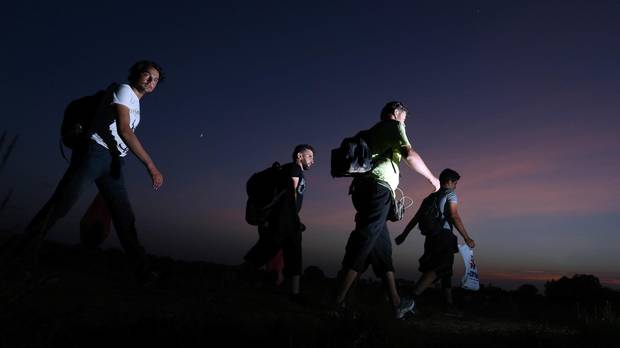Europe's welcome for refugees has faded fast. Five months after the image of little Alan Kurdi lying dead on a Turkish beach – which inspired German Chancellor Angela Merkel to declare her country could take many more refugees – the mood here darkens by the day.
Last week, it was Sweden – long perceived as the European country most welcoming of newcomers – declaring it expected to reject as many as half the 160,000 asylum applications it received in 2015, and that tens of thousands of people would be deported. Finland and Austria quickly followed with similar plans (Finland said it might reject as many as two-thirds of its 32,000 refugee applicants).
Denmark and Switzerland made their growing hostility to newcomers plain another way, introducing laws allowing for the seizure of refugees' jewellery and other valuables as a crude method of helping subsidize asylum-seekers' costs to the state. Bavaria and other south German states have taken similar steps.
Meanwhile, discussion spread about kicking Greece out of the continent's visa-free Schengen Area, a move that would effectively bottle up refugees in the economically failing country, turning Greece into a giant holding pen.
British Prime Minister David Cameron captured Europe's darkening zeitgeist when he disparagingly referred to the thousands of people camped in the French port of Calais – people hoping to reach the United Kingdom – as "a bunch of migrants" that the Labour Leader Jeremy Corbyn would foolishly admit into the country if he ever gained office.
(Mr. Cameron this week hosted a donors' conference that raised $6-billion for the refugee crisis. It was a commendable effort, but delegates to the conference openly spoke of as an effort to deter more people from coming to Europe via making life somewhat more bearable in the refugee settlements of the Middle East.)
Canada, watching from afar – and worried about integrating the much smaller number of Syrian refugees now arriving – would be wise not to follow Europe's down this dimly lit path, or draw the wrong lessons from it.
Our refugees are different from their refugees. And our integration challenges will be different too.
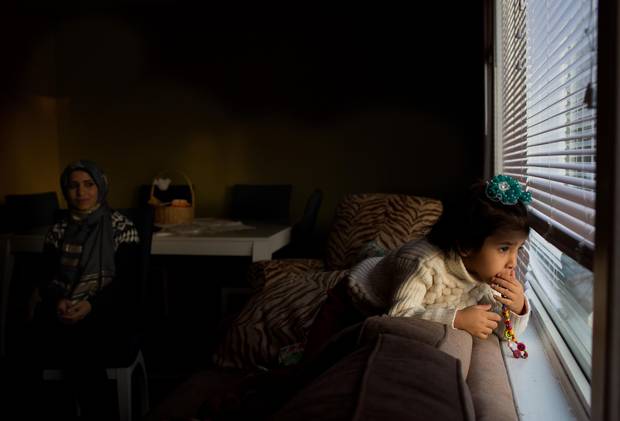
Karim Dalaa, 3, looks out the window at home as her mom Zamzam Dalaa looks on in Edmonton, Alberta in December 2015. The newly arrived refugees were sponsored by a local community group.
AMBER BRACKEN/for The Globe and Mail
Europe's backlash began on the heels of the awful events that took place in Cologne, Germany, on New Year's Eve, when crowds of young men – described as "North African or Arabic" in appearance, and apparently including some recent arrivals – mobbed, robbed and in some cases sexually assaulted young women near the city's main train station.
It was an incident that gave the continent's right-wingers fresh ammunition for their argument that the more than one million recently arrived Syrians, Iraqis, Afghans and other refugees don't fit into European society; that they're collectively a threat to the continent's values. A poll released last week found 40 per cent of Germans thought Ms. Merkel should quit over her decision to open the country's doors to refugees.
But the threat isn't the refugees' culture, it's the gender mix that Europe is importing. And that's directly connected to the deadly sea crossings that have taken the lives of Alan Kurdi and more than 4,000 others since the start of last year.

Turkey’s unsafe passage: High winds, frigid waters – and people are dying
Under pressure from Europe, Turkish authorities have cracked down on refugee crossings, and sparked a fatal game of cat and mouse, the Globe's Mark MacKinnon reports
Read the articleThe European Union signed a deal last month that will see it pay the Turkish government $4.5-billion to step up its efforts to stem the flow of illegal migrants attempting the crossing to Greece. In exchange, Turkish police are making a more visible effort to crack down on the smugglers who charge around $1,000 per person to arrange a rubber dinghy trip to such Greek islands as Lesbos, Kos and Chios.
But all Turkish police are accomplishing is to push the smugglers to find new and often more dangerous routes. The arrival numbers in Greece – 3,500 a day in January – show that the refugees keep coming anyway. If anything, Europe should be bracing for even greater numbers to arrive at its borders in 2016.
And yet, none of the EU's $4.5-billion is going where it's needed most: to a ferry terminal that would make it safer for those determined to make the crossing to Greece's outlying islands.
And so, people continue to die: at least 244 in January of this year alone (when more than 65,439 people made sea crossings to either Greece or Italy in the dangerous winter waves, compared to 5,550 last year, when 82 people died).
It's a ludicrous situation, especially when witnessed from the shores of Lesbos, where earlier this year I watched a flimsy dinghy bob to shore with a few dozen desperate people aboard. Their survival was in question until the minute they touched land, when they were immediately wrapped in blankets and dry clothes, and given medical checks by teams of aid workers and volunteers waiting on the rocky beach.
Anyone who intervened to help the refugees a moment earlier risked being charged under Greek law for aiding illegal entry into the country. But once the refugees touch land, the Greek government allows the volunteers to do their work, and itself moves as quickly as possible to get the new arrivals on to Athens, and then on buses towards the Macedonian border and central Europe beyond.
In other words, if you survive the sea journey, the hardest part of the trip is over. Even the authorities start helping you with the trek onwards.
Still, the EU and Turkey balk at making the sea crossing easier, since it would almost certainly encourage even greater numbers of people to try to reach Europe (although a well-regulated ferry terminal would also allow for document screening in Turkey, while cutting the smugglers out of the game).
But leaving the dangers in place is doing Europe no favours. The hazards associated with the journey ensure that Europe will continue to receive a disproportionate – and socially unhealthy number – of unaccompanied young men.
I've interviewed enough refugees over the past eight months of this crisis to see a pattern: The young men travelling alone to Europe are their family's chosen delegate. They're sent to stake out a new future, to find a job and eventually gain residency and citizenship. They're planting the family's flag. The plan is to some day bring the rest of the clan over.
This isn't necessarily bad news for Europe. This is an aging continent, one that can use an influx of talented young workers. But the prices that smugglers extract mean that most families can only afford to send one member, so they pick their best-educated or most-skilled child. The dangers of the trip mean that most families will choose to send a son over an equally talented daughter.
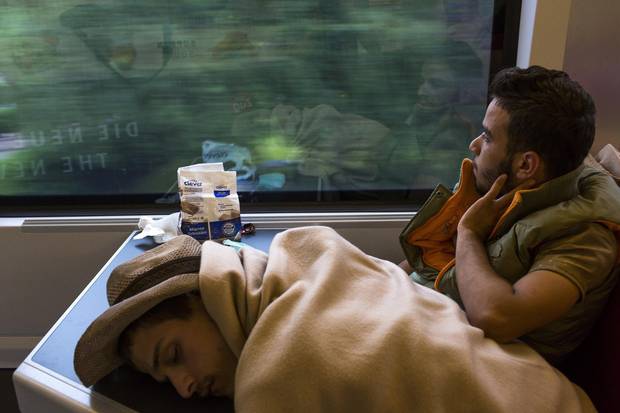
A Syrian refugee gazes out the window at the Austrian countryside while riding a train bound for Munich, Germany in September 2015.
DAVID MAURICE SMITH/for The Globe and Mail
Statistics compiled by the United Nations High Commissioner for Refugees show 57 per cent of the just over one million people who have arrived on the islands of either Greece or Italy since the start of last year were adult males, versus 17 per cent women and 27 per cent children. Strip out the under 18s, and 77 per cent of the adults who made "irregular entries" to Europe were men (compared with 66 per cent in 2012, before the refugee crisis began in earnest).
Those numbers come with unpredictable consequences. In Sweden, the country that has received the highest per capita number of asylum applications, The Economist magazine forecast that the country's gender ratio would tip from 105 to 107 men per 100 women if all the new arrivals were allowed to stay. Among 14- to 17-year-olds – where new arrivals are overwhelmingly male – the figure would rise from 106 to 116 per 100 women. A country that stands as a world leader in gender equality may soon have an imbalance similar to China's.
Canada, in contrast, will have very different, but equally challenging, integration issues. The bulk of the 25,000 Syrians that the government and private sponsors are in the midst of resettling have almost nothing in common with the refugee population arriving in Europe.
Europe is chaotically receiving the youthful cream of the crop. Canada, by relying on the UNHCR to lead its selection process, is receiving Syria's poorest and most vulnerable. Where Europe is receiving too many young men, most of those Canada is resettling are families, often with female heads of households, the men often having died in the war.
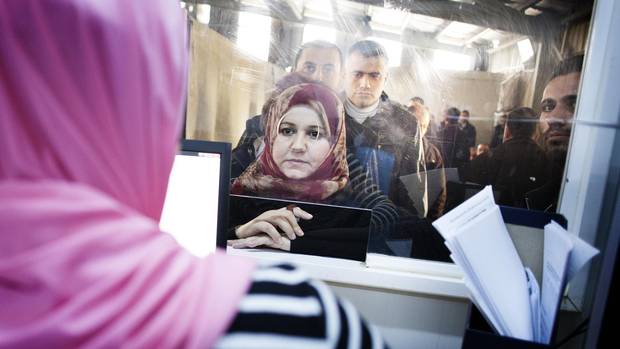
Syrian refugees line up at the UNHCR registration office in Amman, Jordan in November 2015 for an interview that would determine whether they are eligible for a second interview by Canadian authorities.
ANNIE SAKKAB/for The Globe and Mail
I've interviewed large numbers from both refugee pools. Those I've met waiting on the beaches of Turkey hoping to cross to Greece, or walking through the Balkans as they broke borders on their way north, have been predominantly men. But while that was unsettling – where were the women and children? – many had impressive skill sets. I've met refugees who were lawyers, engineers and university professors back home before the wars.
Languages were another asset. If I was speaking to a group of six or seven Syrians, Afghans or Iraqis, at least one or two of the group usually spoke some English. I've met asylum-seekers who spoke French and German too.
The 25,000 refugees Canada is importing contrast with Europe's new arrivals in almost every way. Generally speaking, they were the most economically vulnerable of the Syrian refugees living in Jordan, Turkey and Lebanon because they hadn't been affluent before the war either. It's simple math: Those who were poor in pre-war Syria ran through their savings before rich refugees did.
As international aid dwindled – last year the world funded just 40 per cent of an $8.4-billion United Nations appeal for Syria – they were the ones who suffered most from declining food stipends and dwindling school spaces. They were the ones who couldn't even contemplate paying a smuggler thousands of dollars to take them to Europe.
They were Syria's olive farmers and shopkeepers before the war, not its university graduates. Of the dozens of refugees headed to Canada that I met (and I was focused on the government-selected pool, rather than private sponsorships), I can remember only one who spoke passable English.
Many of their kids, worryingly, had been out of school for years.
Our challenge, then, will be completely different than Europe's. Don't look to Cologne and shudder. Look instead to the alienated suburbs of Paris and Brussels, where the children of Muslim immigrants were allowed to grow up as angry outsiders within French and Belgian society. Look to Canada's own native reserves, where a community that started behind was allowed to fall even further behind.
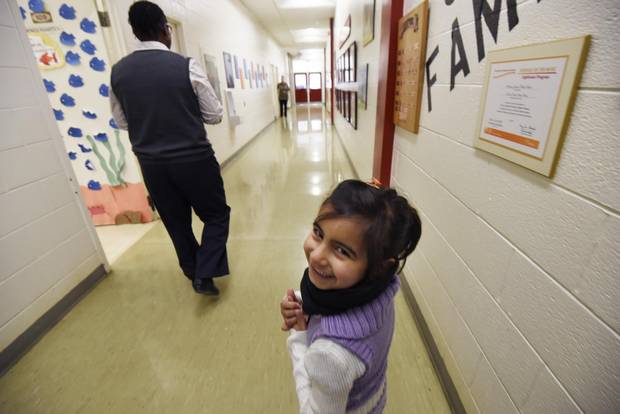
Five year old Mariah Al Rassoul follows Iroquois Junior Public School principal Marcia Pate to her first day in kindergarten class in Toronto. Six Syrian refugee children joined the school on Jan. 4, 2016 after arriving in Canada a month earlier.
FRED LUM/The Globe and Mail
The Syrians arriving in Canada pose almost no security threat. They've passed more checks than anyone else in the country.
But there's still a time bomb that needs to be defused. The parents need immediate help, with language lessons and other necessary skills for coping in the very alien society they've just arrived in.
Their children will require even more direct engagement to help them catch up for the years of missed schooling. They will almost certainly need scholarship programs that give them preferential access to postsecondary education.
Despite some hiccups, Canada's various levels of government – with a big assist from church groups and volunteers – are off to an impressive start resettling the new arrivals. But the effort can't wane.
Europe's reception for refugees is growing cool. If Canada is going to avoid serious longer-term problems of our own, our welcome has to keep getting warmer.
